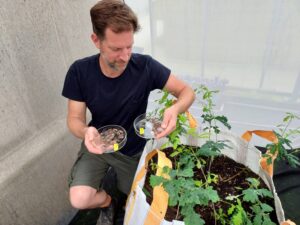Delphy wants to start research under controlled conditions on how to tackle grubs. To this end, Delphy has worked on a breeding system of cockchafers at the Research Nursery for Tree Cultivation and Perennial Horticulture in recent years. It has also invested in monitoring the beetles with the camera system PATS-C.
Problem
Researcher Jeroen van der Meij explains that grubs are a major problem in nursery crops, but also on golf courses, grassland and other crops. Green grubs are strongly curved larvae with a sac-like abdomen of the cockchafer, June beetle, rose chafer or leaf beetle. The life span of the larvae varies between species and can range from 1 to 4 years. They feed on the roots of plants and can cause enormous damage as a result.
Approach
According to Van der Meij, there is a lot of need to tackle grubs properly. ‘Many field trials have been conducted in the past, but results were often very variable. We think we can test new possibilities with research under controlled conditions and have therefore invested last two years in setting up a culture of beetles and grubs. We are pleased that this has succeeded. Now we can start conducting admission research for clients, for example, or look at other innovative developments. In this way, we hope to help practitioners with new solutions against a major problem.’
When setting up the breeding system, Delphy also worked with PATS to look at the possibilities of automated scouting of flying cockchafers. The PATS-C system was used at the Research Nursery for this purpose. Observations are made using a camera system. An online dashboard provides insight into the development of the pest. Van der Meij: ‘That system worked nicely and provided good insight into the flight. The cockchafers flew for a period of four weeks, but at a fixed time, only one hour a day. PATS also has bat-like micro-drones that are used in greenhouse farming to capture butterflies away. Maybe there are opportunities for that in open cultivation too.’

Culture system grubs – Researcher Jeroen van der Meij


